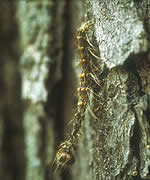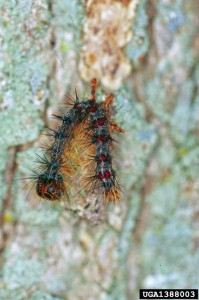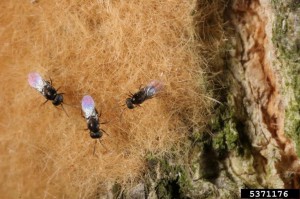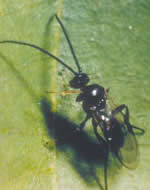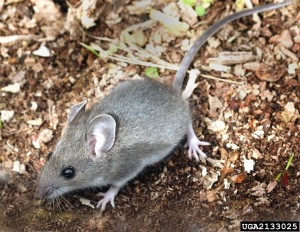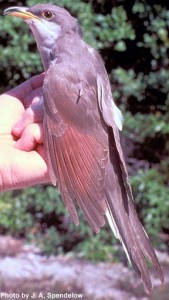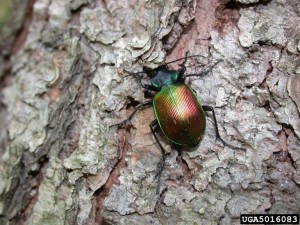Introduction and spread of natural enemies
Although natural enemies have spread westward along with spongy moth (Lymantria dispar), it was unclear whether spread of specialist enemies would be slowed in Wisconsin’s isolated infestation. In 1996 and 1997, the Department of Natural Resources conducted a survey of parasitoids and diseases already present. Following the survey, researchers introduced three species to the area to supplement natural spread. Results of the survey and the sustainability of the introduced natural enemies are summarized below.
Survey results. Entomophoga maimaiga was found at one site in the Door Peninsula; nucleopolyhedrosis virus (NPV) and Cotesia melanoscela were present at a site near the southern end of Green Bay; dipteran parasitoids were present throughout the range of spongy moth; and Ooencyrtus kuvanae was present at five sites in the base of the Door Peninsula.
Supplementing natural populations. The DNR used three criteria to evaluate candidate species: does it have a high degree of specificity to spongy moth, is it able to establish in low-density spongy moth populations and survive in our climate, and is it readily available. Three species (Entomophaga maimaiga, Ooencyrtus kuvanae, and Cotesia melanoscela) fit the criteria and were introduced in areas of Wisconsin where spongy moth had been established for 4 years. The following discussion describes release methods, subsequent spread and recovery, and recommendations for each species.
Entomophaga maimaiga— This fungus was introduced using ground up cadavers of infected spongy moth larvae, a source that was expected to provide a high concentration of spores. The spores were spread in September, October, and November. In subsequent surveys, this pathogen was recovered at approximately 50% of the sites. Recovery appeared to be influenced by rainfall. This species is a good choice for introductions into newly established and isolated populations of spongy moth. As of 2000, E. maimaiga has moved into central Wisconsin. Although its spread westward is primarily the result of natural movement, the DNR releases appear to have been beneficial in accelerating its establishment. Natural spread will likely play a larger role during wet years now that spongy moth is more established in eastern Wisconsin.
Photo Credit: MSU
Nucleopolyhedrosis virus (NPV) – This is a naturally-occuring virus that only infects spongy moth. The virus is ingested by caterpillars and then destroys the internal organs of the insect. Dead and dying caterpillars hang limply and additional virus particles can be released to the surrounding area at that time. Researchers at the US Forest Service have developed a formulation of NPV called Gypchek, that can be applied to supplement natural NPV levels. These applications can be highly effective against small spongy moth caterpillars.
Photo Credit: Steven Katovich. Image 1388003. Forestryimages.org
Ooencyrtus kuvanae—This tiny wasp was collected off infested spongy moth egg masses from wild populations in Michigan and released in Wisconsin sites in early fall. O. kuvanae were recovered at about 35% of the release sites. The spread of Ooencyrtus was not greatly aided through introductions. This species has spread rapidly on its own, though. In fact, most populations found during surveys were not associated with introductions. However, this species is easy for the public to find when spongy moth is at moderate levels, making it a good ambassador species for promoting the concept of biological control. Ooencyrtus is easy to obtain, inexpensive, and fairly specific to spongy moth when collected from wild populations.
Photo Credit: Gyorgy Csoka Hungary Forest Research Institute. Image 5371176. Forestryimages.org
Cotesia melanoscela—Captive-bred cocoons of these wasps were released at two sites in late fall. The timing was chosen to reduce mortality from parasitism. Only 62% emerged the following spring and no adults have since been collected. The success of Cotesia introductions is difficult to measure using the burlap band survey technique. However, searches of young larvae at release sites also failed to show evidence of this species. Pest managers might consider the ability to recover a species when selecting a natural enemy as a lack of results could present a problem for maintaining support for a biological control program.
Photo Credit: Roger Fuester
Native natural enemies
Deer mice—The most important native natural enemy of spongy moth is the white-footed mouse or deer mouse. This cute rodent relishes spongy moth pupae and will also attack the large caterpillars, skinning and gutting them before feasting. Deer mice can have a dramatic effect on the growth of spongy moth populations. Evidence of their effectiveness can be seen by comparing defoliation of oak trees growing in lawns to those growing in a woodland setting with shrubbery, logs and other cover for mice. Mice avoid crossing exposed areas such as lawns, so caterpillars on those trees are protected and their population soars.
Photo Credit: David Cappaert, Michigan State University. Image 2133025. Forestryimages.org.
Birds—Birds will also feed on spongy moth. Chickadees and nuthatches will peck at egg masses in winter to extract eggs. Few birds will prey upon the caterpillars as the long hairs irritate the thin skin around their eyes. However, some species with longer beaks do feed on the caterpillars. Cuckoos (black and yellow-billed) will congregate where hairy caterpillars such as those of spongy moth are abundant, but they can’t eat enough to bring a population outbreak under control.
Photo Credit: J. A. Spendelow. FWS.gov.
Insects—Beetles and other invertebrates can be important predators on spongy moth. The big, fast ground beetles kill many caterpillars that they find in the tree tops, on the trunks, or on the ground. Predatory stinkbugs inject a digestive fluid into the caterpillars that turns their tissues into a soup which the stinkbug then sucks up.
